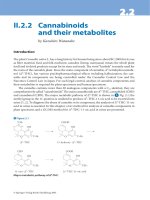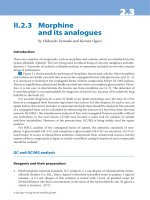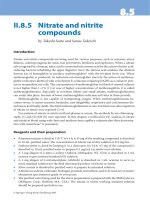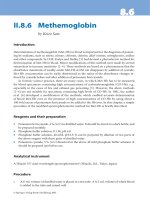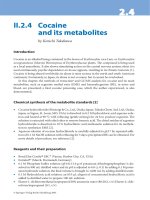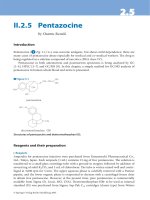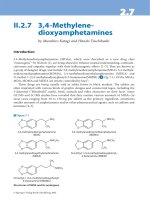Drugs and Poisons in Humans - A Handbook of Practical Analysis (Part 26)
Bạn đang xem bản rút gọn của tài liệu. Xem và tải ngay bản đầy đủ của tài liệu tại đây (259.61 KB, 12 trang )
2.82.8
© Springer-Verlag Berlin Heidelberg 2005
II.2.8 Phencyclidine
by Akira Ishii and Yoshinao Katsumata
Introduction
Phencyclidine ( PCP) (> Fig. 8.1), a synthetic arylcyclohexylamine hallucinogen, had been
rst applied as an anaesthetic to animals and then to humans for a short period. PCP is known
by street names of “ angel dust” and “ crystal”. Illicit use of PCP rst appeared during mid-1960s
along the West Coast, and then peaked in the United States in 1979; illicit PCP use declined by
1992. However, daily use of PCP has remained stable among young school seniors over the past
decade; PCP is thus being an important drug of abuse [1–3]. It is being regulated as a subclass
compound of narcotics and stimulants (DEA Class II).
PCP in both antemortem and postmortem specimens is being analyzed by immunoassays
[4–9], GC [10–13], GC/MS [14–18], GC/MS/MS [19, 20], HPLC [21] and CE [22]. In this
chapter, a detailed procedure for simple GC/MS analysis of PCP in blood and urine is pre-
sented.
Structures of PCP and pethidine (IS).
⊡ Figure 8.1
Reagents and their preparation
i. Reagents
PCP hydrochloride and pethidine ( meperidine) hydrochloride (internal standard, IS) can be
purchased from Sigma (St. Louis, MO, USA) with suitable legal documentation. Bond Elut
Glass columns are obtained from Varian (Harbor City, CA, USA). Other chemicals to be used
are of analytical grade.
242 Phencyclidine
ii. Preparation
• PCP and pethidine solutions: the compounds are separately dissolved in appropriate amounts
of methanol; a 10–20 µL aliquot is spiked into 1 mL of a whole blood or urine specimen.
• 1 M NaHCO
3
solution: 8.4 g of NaHCO
3
is dissolved in distilled water to prepare 100 mL
solution.
• Chloroform/methanol (9:1, v/v): a 100-mL volume of the mixture is prepared.
GC/MS
conditions
GC column
a
: a FactorFour VF-5ms fused-silica capillary column (30 m × 0.25 mm i. d., lm
thickness 0.25 µm, Varian, Harbor City, CA, USA).
GC conditions; instrument: a Varian CP-3800 gas chromatograph with a split-splitless in-
jector (Walnut Creek, CA, USA); column (oven) temperature: 100 °C (1 min)→ 20 °C/min→
300 °C; injection temperature: 250 °C; carrier gas: He; its ow rate: 1.0 mL/min; injection:
splitless mode for 1 min, followed by the split mode (split ratio: 50).
MS conditions; instrument: a Varian Saturn 2000 ion-trap tandem mass spectrometer
b
connected with the above GC; ionization: positive ion EI; electron energy: 70 eV; emission cur-
rent: 10 A; multiplier o set: 230 V; detector voltage: 1.6 kV; scan time: 0.6 s; transfer tempera-
ture: 240 °C; manifold temperature: 45 °C; trap temperature: 210 °C.
Procedure [18]
i. To 1 mL of whole blood or urine specimen containing PCP, are added 100 ng of pethidine
(IS, methanolic solution) and 8 mL distilled water, followed by mixing well. For a whole
blood specimen, it is necessary to con rm the complete hemolysis. A 1-mL volume of 1 M
NaHCO
3
solution is added to the above mixture to bring its pH to about 8.
ii. A 10-mL volume of methanol and 10 mL distilled water are passed through a Bond Elut
Glass column to activate it. is procedure is repeated at least twice.
iii. e above mixture is loaded onto the column, and the column is washed with 20 mL dis-
tilled water.
iv. PCP and IS are slowly eluted with 3 mL of chloroform/methanol (9:1) into a glass vial.
v. A small amount of upper aqueous layer is carefully removed by aspiration with a Pasteur
pipette. e organic layer (chloroform) is evaporated to dryness under a stream of nitro-
gen. e residue is dissolved in 50 µL methanol; a 2-µL aliquot of it is injected into GC/MS
being operated in the mass chromatographic mode.
vi. Combined ions at m/z 242 plus 200 are analyzed for PCP and those at m/z 246 plus 232
plus 218 are analyzed for IS from 4 to 12 min of retention time.
vii. A calibration curve is constructed by adding various concentrations of PCP and 100 ng IS
to the vials containing 1 mL of blank whole blood or urine and 8 mL distilled water
each, followed by the above procedure. e number of di erent concentrations of PCP
should not be smaller than 4. e calibration curve is composed of PCP concentration
on the horizontal axis and peak area ratio of PCP to IS on the vertical axis. e peak ar-
ea ratio of a test specimen is applied to the calibration curve to calculate its concentra-
tion.
243Phencyclidine
Assessment of the method
> Table 8.1 shows EI mass spectra of PCP and IS. In this method, combined ions at m/z 242
([M–1]
+
) plus 200 and those at m/z 246 ([M–1]
+
) plus 232 plus 218 are used for PCP and IS,
respectively. e mass chromatograms of PCP and IS are shown
> Fig. 8.2.
e detection limit (S/N = 3) was about 5 ng/mL for PCP. According to NIDA guidelines, the
cuto level of PCP in urine samples is 25 ng/mL. e toxic concentrations of PCP in blood were
reported to be 7–240 ng/mL; the fatal blood levels were 1–5 µg/mL [23]. us, the present meth-
od can be su ciently applicable for detection and quantitation of toxic levels of PCP in blood.
e recoveriy of PCP using the Bond Elut Glass column was about 100 % for whole
blood [18].
⊡ Table 8.1
EI mass spectra of PCP and pethidine (IS)
Compound m/z (% peak intensitiy)
PCP 200 (100) 242 (84) 84 (24) 91 (18) 186 (13)
IS 246 (100) 71 (98) 172 (84) 232 (63) 218 (46)
Mass chromatograms for PCP and pethidine (IS) extracted from whole blood. In this system,
ions at m/z 200 plus 242 (PCP) and at m/z 246 plus 232 plus 218 (IS) were used at the retention
time of 4–12 min. The amounts of PCP and IS spiked into 1 mL blank whole blood were 25 and
100 ng, respectively.
⊡ Figure 8.2
Poisoning case, and toxic and fatal concentrations
A 28-year-old white man [24], who had had a history of drug abuse, exhibited bizarre behav-
ior on an airline ight; he was transferred to the University of California, San Diego Medical
244 Phencyclidine
Center. At admission, he stared straight ahead, following commands but not responding
verbally; the levels of serum creatinin kinase and aspartate aminotransferase were more
than 100-times the normal limits. On hospital day 2, he became rigid, diaphoretic and had
a temperature reaching 39.2 °C; he was treated for neuroleptic malignant syndrome. On
day 4, the serum PCP concentration reached 1,879 ng/mL, the highest level during the course.
On day 8, he required intubation due to respiratory failure; his temperature increased to
41.4 °C. On day 11 (13 days a er ingestion), he was found to pass two plastic bags through his
rectum; one bag had been ruptured. He had probably swallowed the two plastic bags contain-
ing PCP powder, one of which had been ruptured to cause the PCP poisoning. On hospital
day 12, he made a rapid neurologic recovery; he was discharged with clear consciousness on
day 24.
A similar case of protracted coma, caused by an intestinal deposit containing PCP, was also
reported; the highest PCP concentration in serum reached 1,690 ng/mL [25].
A fatal PCP poisoning case associated with hypertensive crisis [26], and two sudden death
cases during arrest associated with PCP poisoning [27] were reported.
ree death cases, resulting from the PCP use, were reported in Los Angeles County, 1976;
PCP concentrations in blood and the liver ranged from 2.0 to 19.0 µg/mL and from 1.7 to
32.7 µg/g, respectively [28].
Cravey et al. reported nine PCP-related deaths; the concentrations in blood and the livers
ranged from 0.3 to 12 µg/mL (average: 2.4 µg/mL) and from 0.9 to 80 µg/g (average: 20.1 µg/g),
respectively [29].
Notes
a) Any capillary column of 5 % phenylsiloxane/95 % dimethylsiloxane stationary phase can
be used, regardless of manufacturers; but GC/MS grade columns are recommendable.
b) Any modern type of GC/MS instruments can be used. e present instrument can be used
as a GC/MS/MS system; the better selectivity can be obtained in the tandem mode.
References
1) Zukin SR, Sloboda Z, Javitt DC (1997) Phencyclidine (PCP) In: Lowinson JH, Ruiz P, Millman RB (eds) Substance
Abuse: A Comprehensive Textbook, 3rd edn. Williams & Wilkins, Baltimore, pp 238–246
2) Gorelick DA, Balster RL (1996) Phencyclidine (PCP). In: Bloom FE, Kupfer DJ (eds) Psychopharmacology: The
Forth Generation of Progress. Raven Press, New York, pp 1767–1776
3) Schneider S, Kuffer P, Wennig R (1998) Determination of lysergide (LSD) and phencyclidine in biosamples. J
Chromatogr B 713:189–200
4) ElSohly MA, Stanford DF (1990) Cutoff of 25 ng/mL for the EMIT d.a.u. phencyclidine assay. J Anal Toxicol
14:192–193
5) Armbruster DA, Krolak JM (1992) Screening for drugs of abuse with Roche ONTRAK assays. J Anal Toxicol
16:172–175
6) Asselin WM, Leslie JM (1992) Modification of EMIT assay reagents for improved sensitivity and cost effective-
ness in the analysis of hemolyzed whole blood. J Anal Toxicol 16: 381–388
7) Sneath TC, Jain NC (1992) Evaluation of phencyclidine by EMIT
®
d.a.u.™ utilizing the ETS
®
analyzer and a 25-ng/
mL cutoff. J Anal Toxicol 16:107–108
8) Diosi DT, Harvey DC (1993) Analysis of whole blood for drugs of abuse using EMIT d.a.u. reagents and a Mon-
arch 1000 chemistry analyzer. J Anal Toxicol 17:133–137
245Phencyclidine
9) Parsons RG, Kowal R, LeBlond D et al. (1993) Multianalyte assay system developed for drugs of abuse. Clin Chem
39:1899–1903
10) Kandiko CT, Browning S, Cooper T et al. (1990) Detection of low nanogram quantities of phencyclidine extract-
ed from human urine preparation of an acetylated column packing material for use in gas chromatography
with nitrogen-phosphorus detection. J Chromatogr 528:208–213
11) Werner M, Hertzman M, Pauley CJ (1986) Gas-liquid chromatography of phencyclidine in serum, with nitrogen-
phosphorus detection. Clin Chem 32:1921–1924
12) Ishii A, Seno H, Kumazawa T et al. (1996) Simple and sensitive detection of phencyclidine in body fluids by gas
chromatography with surface ionization detection. Int J Legal Med 108:244–247
13) Ishii A, Seno H, Kumazawa T et al. (1996) Simple extraction of phencyclidine from human body fluids by head-
space solid-phase microextraction (SPME). Chromatographia 43:331–333
14) Nakahara Y, Takahashi K, Sakamoto T et al. (1997) Hair analysis for drugs of abuse X VII. Simultaneous detection
of PCP, PCHP, and PCPdiol in human hair for confirmation of PCP use. J Anal Toxicol 21:356–362
15) ElSohly MA, Little TL Jr, Mitchell JM et al. (1988) GC/MS analysis of phencyclidine acid metabolite in human
urine. J Anal Toxicol 12:180–182
16) Slawson MH, Wilkins DG, Foltz RL et al. (1996) Quantitative determination of phencyclidine in pigmented and
nonpigmented hair by ion-trap mass spectrometry. J Anal Toxicol 20:350–354
17) Stevenson CC, Cibull DL, Platoff GE et al. (1992) Solid phase extraction of phencyclidine from urine followed by
capillary gas chromatography/mass spectrometry. J Anal Toxicol 16:337–339
18) Ishii A, Seno H, Watanabe-Suzuki K et al. (2000) Ultrasensitive determination of phencyclidine in body fluids by
surface ionization organic mass spectrometry. Anal Chem 72:404–407
19) Kidwell DA (1993) Analysis of phencyclidine and cocaine in human hair by tandem mass spectrometry. J
Forensic Sci 38:272–284
20) Moore CM, Lewis DE, Leikin JB (1996) The determination of phencyclidine in meconium using ion trap mass
spectrometry. J Forensic Sci 41:1057–1059
21) Cook CE, Brine DR, Jeffcoat AR et al. (1982) Phencyclidine disposition after intravenous and oral doses. Clin
Pharmacol Ther 31:625–634
22) Chen F-TA, Evangelista RA (1994) Feasibility studies for simulatneous immunochemical multianalyte drug as-
say by capillary electrophoresis with laser-induced fluorescence. Clin Chem 40:1819–1822
23) Schulz M, Schmoldt A (2003) Therapeutic and toxic blood concentrations of more than 800 drugs and other
xenobiotics. Pharmazie 58:447–474
24) Jackson JE (1989) Phencyclidine pharmacokinetics after a massive overdose. Ann Intern Med 111:613–615
25) Young JD, Crapo LM (1992) Protracted phencyclidine coma from an intestinal deposit. Arch Intern Med
152:859–860
26) Eastman JW, Cohen SN (1975) Hypertensive crisis and death associated with phencyclidine poisoning. JAMA
231:1270–1271
27) Pestaner JP, Southall PE (2003) Sudden death during arrest and phencyclidine intoxication. Am J Forensic Med
Pathol 24:119–122
28) Noguchi TT, Nakamura GR (1978) Phencyclidine-related deaths in Los Angeles County, 1976. J Forensic Sci
23:503–507
29) Cravey RH, Reed D, Ragle JL (1979) Phencyclidine-related deaths: a report of nine fatal cases. J Anal Toxicol
3:199–201


